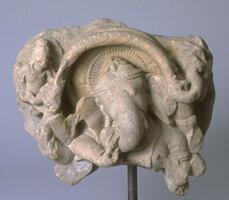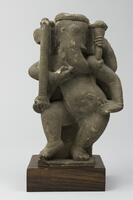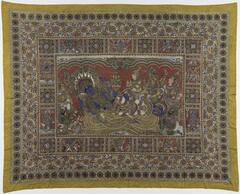Lesson Plan: Ganesha and Vishnu Avatars
“Divine Encounters, Earthly Pleasures: Twenty Centuries of Indian Art,” UMMA Workshop for Educators, 2004
Objectives
Students will understand the concept of an avatar, observe different representations of avatars, and write a story imagining their own transformation.
National Core Standards
Relate artistic ideas and works with societal, cultural, and historical context to deepen understanding
Perceive and analyze artistic work
Produce clear and coherent writing in which the development, organization, and style are appropriate to task, purpose, and audience.
Grades
4-6
Time Required
One or two class periods
Materials
Images of Ganesha and Vishnu assuming various forms
Lesson
- Provide background on Ganesha while observing images of the deity: Ganesha is one of the most well-known Hindu deities. Parvati (the great mother goddess) created her son Ganesha in order to protect her home and her privacy. When Parvati’s husband, Shiva (the god of destruction), found Ganesha would not let him enter his own home, he attacked Ganesha. Parvati defended her son, and thus began a cosmic battle. When Ganesha the boy was transformed into the elephant-headed god, order was restored to the universe. Ganesha is known for providing good fortune and prosperity. He also removes obstacles, opening doors to hopes and dreams. Typically, representations of Ganesh include an elephant head, a round belly, and one broken tusk. He is often dancing, eating sweets, and riding on a mouse. If possible, obtain the book How Ganesh Got His Elephant Head, by Harish Johari and Vatsala Sperling.
- Provide background on Vishnu while observing images of the deity: Vishnu is believed to preserve harmony and cosmic order. He is often depicted with four arms, holding a lotus flower, a conch shell, a mace, and a chakra (disc weapon). In one story about Varaha, the earth has been hidden under water. Flying over the lake, Vishnu saw a lotus flower and smelled life beneath the surface. He assumed the form of a boar, dove down and brought the earth up from below, preserving life and order.
- Define the concept of an avatar: In Sanskrit, “avatar” means “descent” and usually implies the incarnation of a god, descending to earth to fulfill a specific purpose. Hindu sacred texts depict Ganesha as eight avatars, all assumed to slay a demon. Some of Ganesha’s avatars include the King of the World, the Great-Bellied One, the Elephant-Faced One. Vishnu has appeared in the form of ten avatars including a tortoise, a boar, a man-lion, a dwarf, and others. Vishnu assumed the form of Varaha the boar to rescue the world from a demon who had imprisoned the earth beneath a cosmic ocean. Discuss how taking on different forms may help accomplish a task more effectively than consistently staying in the same form. Some students may be familiar with the term avatar because of its appearance in television shows and virtual reality games on the internet. In these games and forums, a person chooses an alternative identity and visual representation.
- Ask students to imagine their own adventure. If they were going to save the earth from trouble, which avatar would they choose? Why?
- Guide students in writing an adventure in which they transform into an avatar or a superhero with an animal helper (such as Ganesh’s mouse mount) to achieve a specific task (this challenge can be provided, such as rescuing the world from a dragon). Students can also illustrate or sculpt the narrative and share with peers.
Part of 1 Learning Collection
Lesson Plan: Translating a Familiar Landscape
“Tradition Transformed: Chang Ku-nien Master Painte...
“Tradition Transformed: Chang Ku-nien Master Painte...
Lesson Plan: Collaborative Scroll of Images and Poetry
“Creative Literacies: Expanding our View,” UMMA Wor...
“Creative Literacies: Expanding our View,” UMMA Wor...
Lesson Plan: Compare and Contrast Drawing and Sculpture
UMMA Exhibition, “The Graphic Dimension: Prints and...
UMMA Exhibition, “The Graphic Dimension: Prints and...
Lesson Plan: Content and Style – Corresponding or Contradicting?
“Creative Literacies: Expanding our View,” UMMA Wor...
“Creative Literacies: Expanding our View,” UMMA Wor...
Lesson Plan: Setting the Scene – Descriptive Writing with Photography
“Teaching with Photography,” UMMA Workshop for Educ...
“Teaching with Photography,” UMMA Workshop for Educ...
Lesson Plan: Not a Failure . . . Just a Draft
“Creative Literacies: Expanding our View,” UMMA Wor...
“Creative Literacies: Expanding our View,” UMMA Wor...
Lesson Plan: Calligraphy and Radial Design in Islamic Art
Lesson adapted from Educator Resources, Victoria & ...
Lesson adapted from Educator Resources, Victoria & ...
Lesson Plan: Memory Maps, Using the Mitchell Map (1755)
“Benjamin West: General Wolfe and the Art of Empire...
“Benjamin West: General Wolfe and the Art of Empire...
Lesson Plan: Multipoint Perspective: Using Art to Teach Writing
“Creative Literacies: Expanding our View,” UMMA Wor...
“Creative Literacies: Expanding our View,” UMMA Wor...
Lesson Plan: The New Sublime and Photographic Landscape
“Teaching with Photography” UMMA Teacher Workshop,...
“Teaching with Photography” UMMA Teacher Workshop,...
Lesson Plan: Panorama Handscroll Using Multiple Literacies
Lesson inspired by Elaine Wilson’s “Charting the Wo...
Lesson inspired by Elaine Wilson’s “Charting the Wo...
Lesson Plan: Playing with Scale in Landscape or Still Life
“Tradition Transformed: Chang Ku-nien Master Painte...
“Tradition Transformed: Chang Ku-nien Master Painte...
Lesson Plan: Exploring the Emotional Impact of Portraiture Through Free Writing
UMMA Teacher Workshop, “Xu Weixin: Monumental Portr...
UMMA Teacher Workshop, “Xu Weixin: Monumental Portr...
Lesson Plan: Positive and Negative Space in Photography
“Teaching with Photography,” UMMA Workshop for Educ...
“Teaching with Photography,” UMMA Workshop for Educ...
Lesson Plan: Setting Up a Collaborative Short Story
“Teaching with Landscape Photography,” UMMA Teacher...
“Teaching with Landscape Photography,” UMMA Teacher...
Lesson Plans: Ideas for Writing with Portraits
UMMA Teacher Workshop, “Xu Weixin: Monumental Portr...
UMMA Teacher Workshop, “Xu Weixin: Monumental Portr...
Lesson Plan: Zoom In: The Significance of Detail
“Creative Literacies: Expanding our View,” UMMA Wor...
“Creative Literacies: Expanding our View,” UMMA Wor...
Rate this Resource
AVG: 0 | Ratings: 0
& Author Notes
Creative Commons by-nc-saLast Updated
June 19, 2017 12:18 p.m.Report
Reporting Policy




